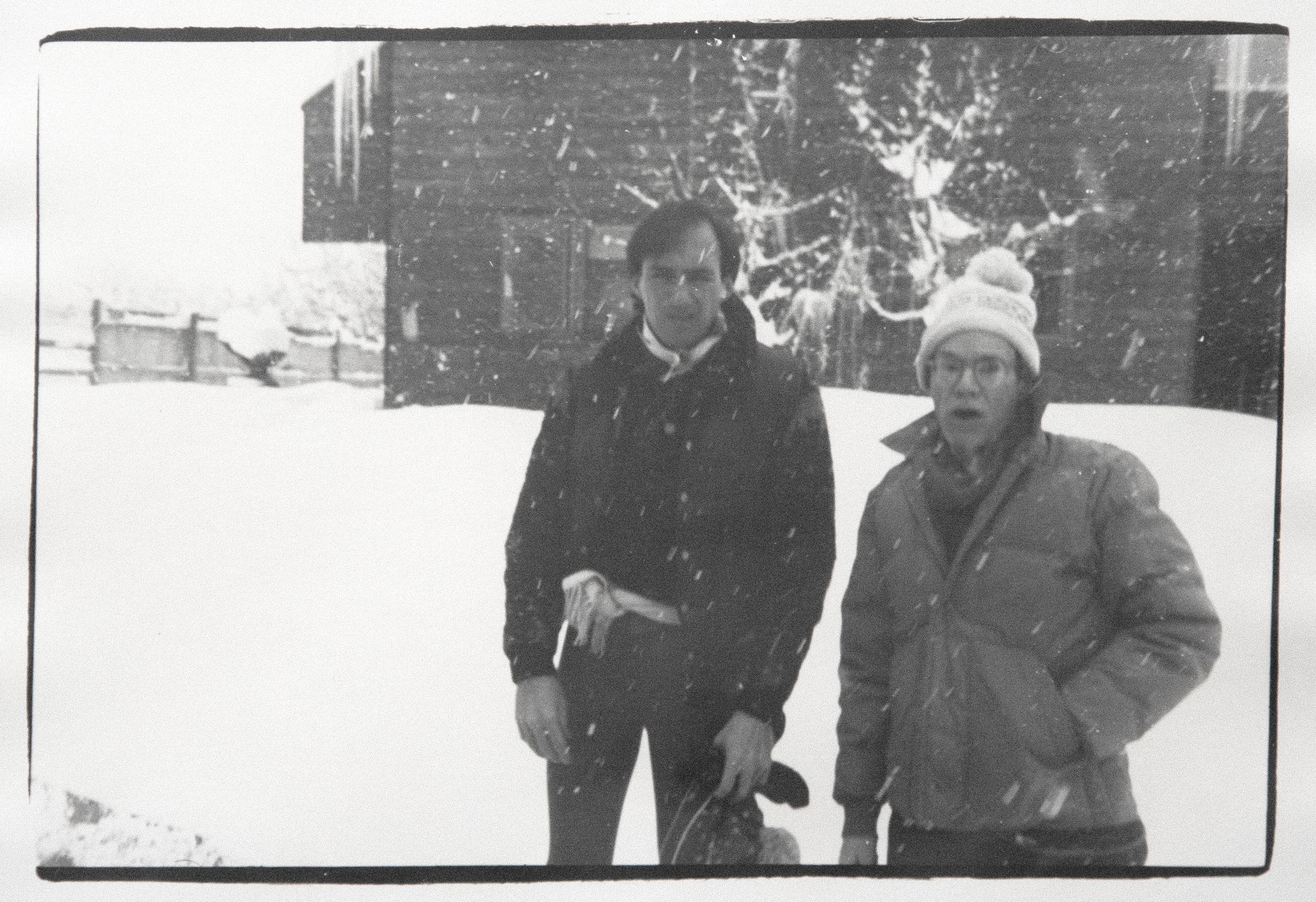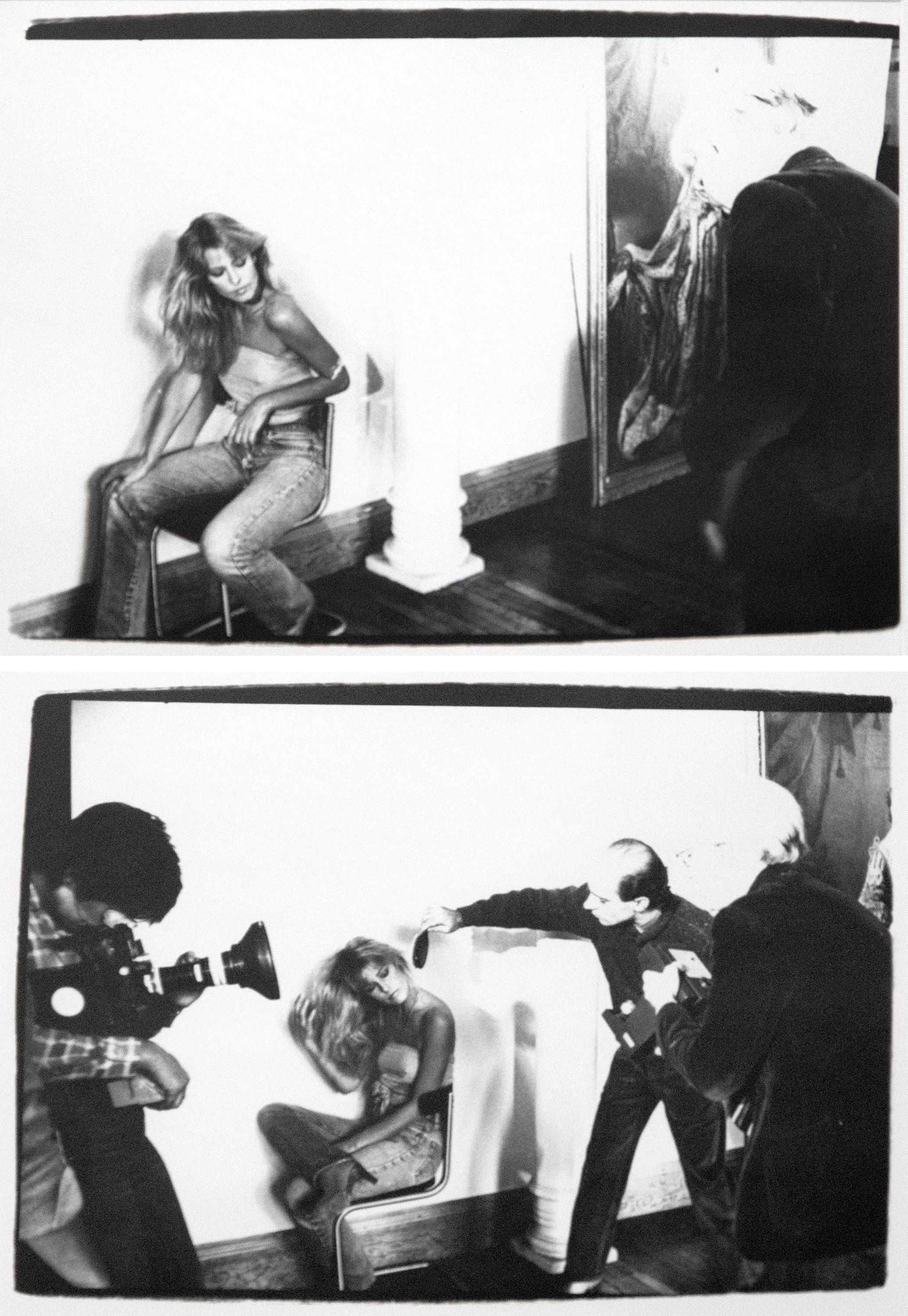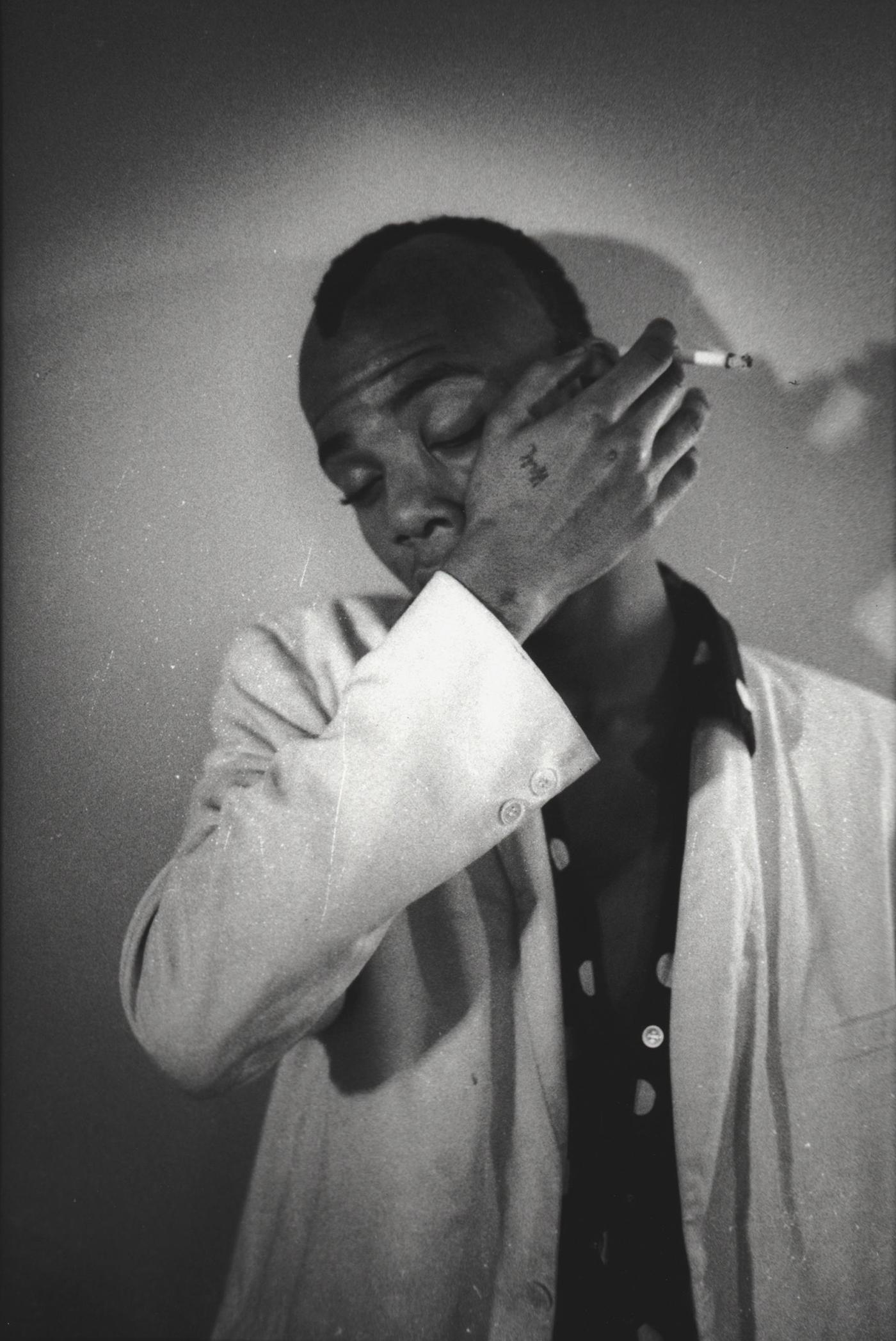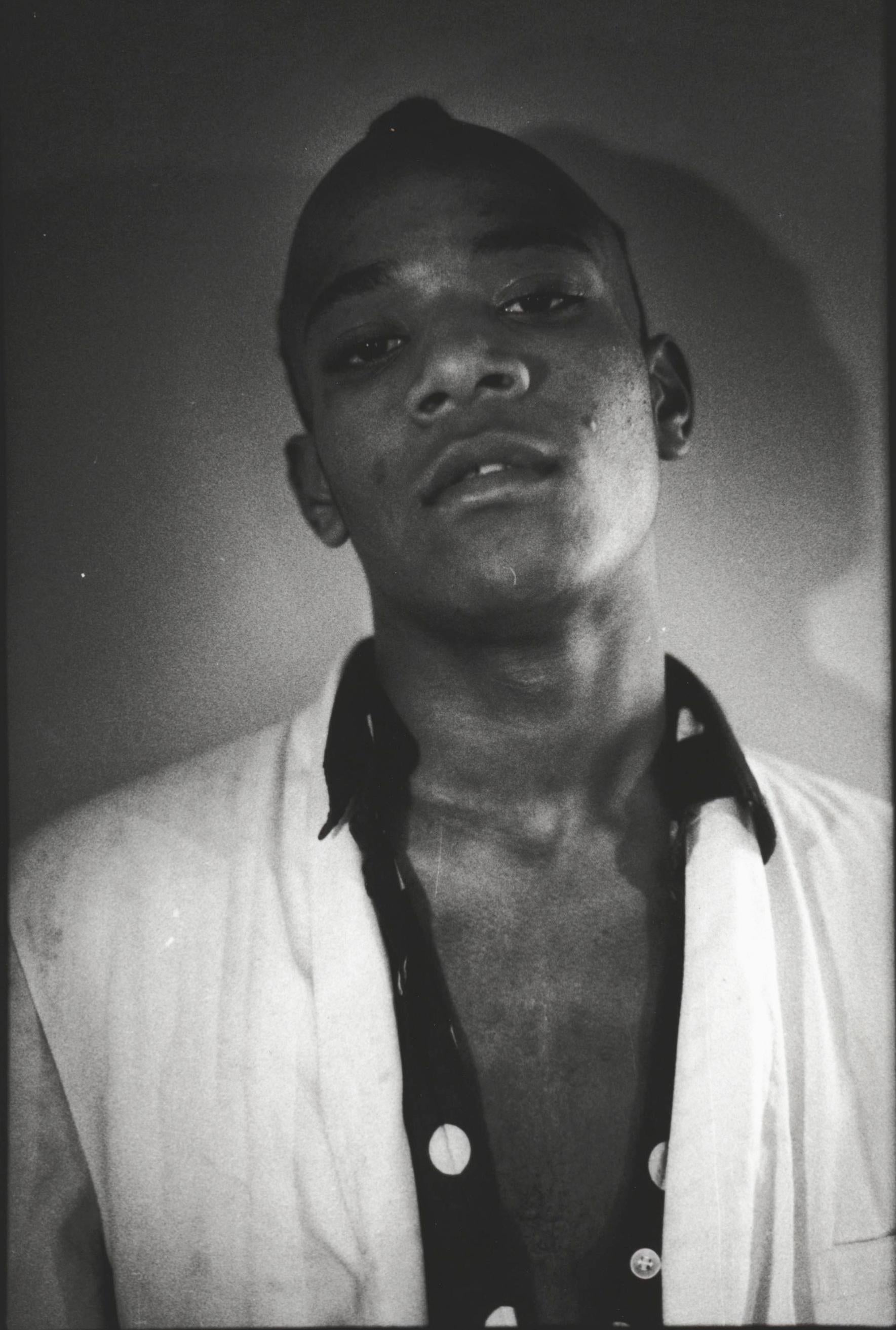Andy WarholGrace Jones and Steve Rubell1980
1980
About the Item
- Creator:Andy Warhol (1928 - 1987, American)
- Creation Year:1980
- Dimensions:Height: 8 in (20.32 cm)Width: 10 in (25.4 cm)
- Medium:
- Movement & Style:
- Period:
- Condition:
- Gallery Location:Palm Desert, CA
- Reference Number:
Andy Warhol
The name of American artist Andy Warhol is all but synonymous with Pop art, the movement he helped shape in the 1960s. He was phenomenally prolific, and the archive of original photography, prints, drawings, paintings and other art that he left behind is beyond vast.
Andy Warhol is known for his clever appropriation of motifs and images from popular advertising and commercials, which he integrated into graphic, vibrant works that utilized mass-production technologies such as printmaking, photography and silkscreening. Later in his career, Warhol expanded his oeuvre to include other forms of media, founding Interview magazine and producing fashion shoots and films on-site at the Factory, his world-famous studio in New York.
Born and educated in in Pittsburgh, Warhol moved to New York City in 1949 and built a successful career as a commercial illustrator. Although he made whimsical drawings as a hobby during these years, his career as a fine artist began in the mid-1950s with ink-blot drawings and hand-drawn silkscreens. The 1955 lithograph You Can Lead a Shoe to Water illustrates how he incorporated in his artwork advertising styles and techniques, in this case shoe commercials.
As a child, Warhol was often sick and spent much of his time in bed, where he would make sketches and put together collections of movie-star photographs. He described this period as formative in terms of his skills and interests. Indeed, Warhol remained obsessed with celebrities throughout his career, often producing series devoted to a famous face or an object from the popular culture, such as Chairman Mao or Campbell’s tomato soup. The 1967 silkscreen Marilyn 25 embodies his love of bright color and famous subjects.
Warhol was a prominent cultural figure in New York during the 1960s, ’70s and ’80s. The Factory was a gathering place for the era’s celebrities, writers, drag queens and fellow artists, and collaboration was common. To this day, Warhol remains one of the most important artists of the 20th century and continues to exert influence on contemporary creators.
Find a collection of original Andy Warhol art on 1stDibs.
- ShippingRetrieving quote...Ships From: Jackson, WY
- Return PolicyA return for this item may be initiated within 7 days of delivery.
- Jon Gould and Andy WarholLocated in Palm Desert, CAA photograph by Andy Warhol. “Jon Gould and Andy Warhol” is a silver gelatin print by American Pop Artist Andy Warhol. The artwork is numbered FL06.00463 and...Category
Late 20th Century Pop Art Figurative Photography
MaterialsSilver Gelatin
- Andy Warhol and Janice DickensonLocated in Palm Desert, CAA photograph by Andy Warhol. “Andy Warhol and Janice Dickenson” is a silver gelatin print by American Pop Artist Andy Warhol. The artwork is numbered AWL254 by the Andy Warhol Founda...Category
Late 20th Century Pop Art Figurative Photography
MaterialsSilver Gelatin
- Farrah Fawcett Photo ShootBy Andy WarholLocated in Palm Desert, CAA set of two photographs by Andy Warhol. “Farrah Fawcett Photo Shoot” is a set of two silver gelatin prints by American Pop Artist Andy Warhol. The artw...Category
Late 20th Century Pop Art Black and White Photography
MaterialsSilver Gelatin
- Marilyn MonroeLocated in Palm Desert, CAA photograph by Lawrence Schiller. ""Marilyn Monroe"" is a nude, figurative vintage silver gelatin photograph in black and white by American Post-War artist Lawrence Schiller. Lawrence Schiller only remembers the 60s in this way: Fast. As in: Blur. Which is, for those who lived through it, as accurate a description as one is likely to find about the decade that began with optimism and ended in chaos. It was ten years of turmoil and exploration. And through this turbulent and tumultuous decade, it often seemed that whenever a headline-making news event occurred, Lawrence Schiller was there. Schiller was not just lucky to be in the right place at the right time; he was prescient. He was there to cover the event, to add to it, to help us see it, to aid its meaning and its depth. ""It was a time in which things happened awfully fast,"" Schiller says of the decade. ""It was a wild, wild period; an uncontrolled period. I don’t think you had any sense of perspective in the 60s. You had to wait and look back at it, because it was a period in which things were happening that had no rhyme or reason to it. But by the end of the ‘60s I had covered so many stories, had so many magazine covers, I had somehow become part of that decade’s history. And I already had my eye on the future."" When Lawrence Schiller got the assignment from the French magazine, Paris Match to photograph Marilyn Monroe on the 20th Century Fox set of Something’s Got to Give, he thought nothing of it. It wasn’t to be a private, studio shoot. He wasn’t going to set up lights, create backgrounds, or use a tripod. Just another assignment, he figured. Monroe by then was firmly established as a figment in the imagination of most young men. The orphan Norma Jean had recreated herself as the blonde bombshell Marilyn Monroe. She’d appeared in twenty-nine films by the time Schiller photographed her in black and white and color in May, 1962. The world was unprepared for the moment when Marilyn jumped in the swimming pool in a flesh-colored bikini and came up out of the water au natural. She was all smiles and in her element: the sex goddess...Category
Mid-20th Century Post-War Black and White Photography
MaterialsSilver Gelatin
- Robert Kennedy, San DiegoLocated in Palm Desert, CAA photograph by Lawrence Schiller. “Robert Kennedy, San Diego” is a figurative photograph, vintage silver gelatin photograph in black and white by American artist Lawrence Schiller. The artwork is signed on the verso. Lawrence Schiller only remembers the 60s in this way: Fast. As in: Blur. Which is, for those who lived through it, as accurate a description as one is likely to find about the decade that began with optimism and ended in chaos. It was ten years of turmoil and exploration. And through this turbulent and tumultuous decade, it often seemed that whenever a headline-making news event occurred, Lawrence Schiller was there. Schiller was not just lucky to be in the right place at the right time; he was prescient. He was there to cover the event, to add to it, to help us see it, to aid its meaning and its depth. "It was a time in which things happened awfully fast," Schiller says of the decade. "It was a wild, wild period; an uncontrolled period. I don’t think you had any sense of perspective in the 60s. You had to wait and look back at it, because it was a period in which things were happening that had no rhyme or reason to it. But by the end of the ‘60s I had covered so many stories, had so many magazine covers, I had somehow become part of that decade’s history. And I already had my eye on the future." When Lawrence Schiller got the assignment from the French magazine, Paris Match to photograph Marilyn Monroe on the 20th Century Fox set of Something’s Got to Give, he thought nothing of it. It wasn’t to be a private, studio shoot. He wasn’t going to set up lights, create backgrounds, or use a tripod. Just another assignment, he figured. Monroe by then was firmly established as a figment in the imagination of most young men. The orphan Norma Jean had recreated herself as the blonde bombshell Marilyn Monroe. She’d appeared in twenty-nine films by the time Schiller photographed her in black and white and color in May, 1962. The world was unprepared for the moment when Marilyn jumped in the swimming pool in a flesh-colored bikini and came up out of the water au natural. She was all smiles and in her element: the sex goddess...Category
Mid-20th Century Post-War Figurative Photography
MaterialsSilver Gelatin
- Andy WarholLocated in Palm Desert, CAA polaroid by Andy Warhol. ""Andy Warhol"" is a Post-War gelatin silver print by American Pop Artist Andy Warhol. The work has been given the Warhol Foundation authentication number ...Category
Late 20th Century Pop Art Portrait Photography
MaterialsSilver Gelatin
- Vintage Silver Gelatin Photograph Marvel Comic Book, Amazing Spider Man Pop ArtLocated in Surfside, FLThis is a vintage silver gelatin photo of either Stan Lee or John Romita (I believe it is Romita but I am not sure) overlayed with a comic strip in a surrealist style. John Romita is an American comic-book artist best known for his work on Marvel Comics' The Amazing Spider-Man and for co-creating the character The Punisher. He was inducted into the Will Eisner Comic Book Hall of Fame in 2002. He graduated from Manhattan's School of Industrial Art in 1947, having attended for three years after spending ninth grade at a Brooklyn junior high school Among his instructors were book illustrator Howard Simon and magazine illustrator Ben Clements, and his influences included comics artists Noel Sickles, Roy Crane, Milton Caniff, and later, Alex Toth and Carmine Infantino, as well as commercial illustrators Jon Whitcomb, Coby Whitmore, and Al Parker. Romita entered the comics industry in 1949 on the series Famous Funnies. "Steven Douglas up there was a benefactor to all young artists", Romita recalled. "The first story he gave me was a love story. It was terrible. All the women looked like emaciated men and he bought it, never criticized, and told me to keep working. He paid me two hundred dollars for it and never published it — and rightfully so". Romita was working at the New York City company Forbes Lithograph in 1949, earning $30 a week, when comic-book inker Lester Zakarin, a friend from high school whom he ran into on a subway train, offered him either $17 or $20 a page to pencil a 10-page story for him as uncredited ghost artist. "I thought, this is ridiculous! In two pages I can make more money than I usually make all week! So I ghosted it and then kept on ghosting for him", Romita recalled. "I think it was a 1920s mobster crime story". The work was for Marvel's 1940s forerunner, Timely Comics, which helped give Romita an opportunity to meet editor-in-chief and art director Stan Lee. Romita ghost-penciled for Zakarin on Trojan Comics' Crime-Smashers and other titles, eventually signing some "Zakarin and Romita". Romita went on to draw a wide variety of horror comics, war comics, romance comics and other genres for Atlas. His most prominent work for the company was the short-lived 1950s revival of Timely's hit character Captain America, in Young Men #24–28 (Dec. 1953 – July 1954) and Captain America #76–78 (May–Sept. 1954).[21] Additionally, Romita would render one of his first original characters, M-11 the Human Robot, in a five-page standalone science-fiction story in Menace #11 (May 1954). While not envisioned as an ongoing character, M-11 was resurrected decades later as a member of the super-hero team Agents of Atlas. He was the primary artist for one of the first series with a black star, "Waku, Prince of the Bantu" — created by writer Don Rico and artist Ogden Whitney in the omnibus title Jungle Tales #1 (Sept. 1954). The ongoing short feature starred an African chieftain in Africa, with no regularly featured Caucasian characters. Romita succeeded Whitney with issue #2 (Nov. 1954). In the mid-1950s, while continuing to freelance for Atlas, Romita did uncredited work for DC Comics before transitioning to work for DC exclusively in 1958. "I was following the DC [house] style", he recalled in 2002. "Frequently they had another artist do the first page of my stories. Eventually I became their romance cover...Category
20th Century Pop Art Black and White Photography
MaterialsSilver Gelatin
- Jean-Michel Basquiat photograph by Nick Taylor of GrayBy Nicholas TaylorLocated in NEW YORK, NYRare 1979 Photograph of Jean Michel Basquiat This rare Basquiat photograph was taken from Nicholas Taylor’s well-documented portfolio exploring his friendship with Jean-Michel Basquiat - a friendship which began when both collaborated on the historic New York No Wave band, “GRAY” in the late 1970s; before the two briefly lived together in the East Village. Selections from Taylor's portfolio were most notably exhibited as part of the Basquiat retrospective at London's Barbican in 2017 and have been featured in numerous noteworthy publications on Basquiat. Silver Gelatin Print. 1979. 11 x 14 inches Hand singed and numbered in the margins from an edition of 5 A/P's. Very good overall vintage condition, with the exception of some minor signs of handling. Provenance: Obtained directly from artist Lot 180 is an authorized dealer rep of Nicholas Taylor Whilst Basquiat often provided glimpses into his conflicted character through his own art, Taylor’s photograph offers an intimate, and perhaps more honest, portrait from the outside. The clever exploration of light and dark reveals the dichotomies that divided the artist; both his fragile and playful, tender and brazen sides are unveiled. A soft glow is cast across Basquiat’s face, communicating a tenderness and affection that only a close friend could capture. About Nicholas Taylor Nicholas Taylor (American, b. 1953) is a renowned photographer and musician. Taylor moved to New York in 1977 to pursue a career as a photographer and it was through the vibrant New York art scene that he came to know the young artist, Jean-Michel Basquiat. It was, in fact, his intimate portfolio of photographs documenting his friendship with Basquiat that rocketed Taylor to fame. The two would collaborate in the seminal No Wave band “Gray” and live together in the East Village, before Taylor launched a successful career as a DJ famous for track-looping. His track “Suicide Mode” would later be used in the soundtrack for Julian Schnabel’s 1996 film “Basquiat." Taylor has been directly referenced in at least two works by Basquiat and is responsible for first introducing the artist to Madonna before the two dated. Taylor's photographs of Basquiat were recently exhibited at London's Barbican and Frankfurt's Schirn Kunsthalle as part of the landmark Basquiat: Boom for Real exhibition; with Gray (Michael Holman & Nick...Category
1980s Pop Art Figurative Photography
MaterialsSilver Gelatin
- BASQUIAT photograph by Nick Taylor of Gray (Basquiat Gray)By Nicholas TaylorLocated in NEW YORK, NYRare 1979 Photograph of Jean Michel Basquiat This rare Basquiat photograph was taken from Nicholas Taylor’s well-documented portfolio exploring his friendship with Jean-Michel Basqui...Category
1980s Pop Art Figurative Photography
MaterialsSilver Gelatin
- Coco Chanel, Paris, 1937, Horst P. HorstBy Horst P. HorstLocated in Fairfield, CTArtist: Horst P. Horst (1906-1999) Title: Coco Chanel, Paris, 1937 Year: 1937 Medium: Silver Gelatin Print Size: 14 x 11 inches Condition: Excellent Inscripti...Category
1930s Pop Art Black and White Photography
MaterialsSilver Gelatin
- FELA KUTI photograph collectionLocated in NEW YORK, NYFela Kuti: A rare vintage collection of: 2 darkroom publicity photos circa ealry/mid 1980s. Each measuring 5x7 inches. 15+ 35mm transparencies of Fela performing live circa early/...Category
1980s Pop Art Black and White Photography
MaterialsSilver Gelatin
- Duncan Hannah Unmade Beds 1976By Fernando NataliciLocated in NEW YORK, NYDuncan Hannah, Unmade Beds 1976 by Fernando Natalici: This rare, vintage original 1970s darkroom photograph was captured on the set of "Unmade Beds" by ...Category
1970s Pop Art Black and White Photography
MaterialsSilver Gelatin
Recently Viewed
View AllRead More
Andy Warhol Piles Up the Gifts in This Fanciful Christmas Print
Created in the late 1950s, it’s one of a surprising number of holiday-themed works by the prolific Pop artist.
Jordan Schnitzer Started Collecting Warhol Prints Very Early — and Never Stopped
The Portland, Oregon, native has amassed a collection of art so outstanding that multiple museums bear his name and several exhibitions at any given time are showing pieces he owns. We caught up with Schnitzer to find out how he got started collecting Warhol and where his pieces can be found right now.






